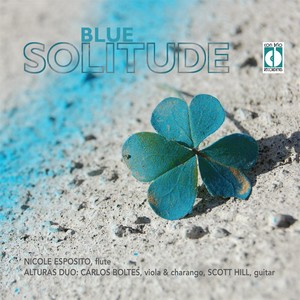
Blue Solitude
- 流派:World Music 世界音乐
- 语种:英语
- 发行时间:2013-03-29
- 类型:录音室专辑
- 歌曲
- 时长
简介
Paisajes, retratos y mujeres (Portraits, Landscapes, and Women) was written for TrioConBrio in 1997 by the esteemed Cuban composer Leo Brouwer (1938- ). This masterful piece reveals a fully matured composer in total command of all the technical and musical possibilities that the three instruments have to offer. The work begins with Retrato de Wagner y Mathilde (Portrait of Wagner and Mathilde) which opens with a graceful three note idea that is varied tonally and rhythmically around a series of contrasting interludes that inevitably circle back to the opening motif. This is followed by Mujer bailando un minueto (Woman Dancing a Minuet) which employs a conventional minuet dance rhythm in three. This takes the listener through a variety of key, rhythm and character changes that are surprisingly interrupted by a scherzo like trio that features a remarkable interplay of rhythmic parlance between the three instruments. The piece ends with La pasión según Dowland (The Passion According to Dowland), a tribute to the great Renaissance composer and lutenist, John Dowland (1563-1626). This final movement begins with a slow and simple melody played by all three instruments that later builds through a series of variations, gaining in force and complexity. As the variations come to a halt, the piece suddenly slows down and concludes with an eerie, yet beautiful epilogue. Elegia and Interlúdio, which form a part of Three Pieces for Flute, Viola and Guitar, were both composed by New York based, Brazilian born composer, Raimundo Penaforte. Elegia was originally part of Sweet New York; a suite for trumpet and piano commissioned by trumpeter, Fernando Dissenha in 1995. It was written as a tribute to Mr. Penaforte’s former teacher, Stephen Albert, upon his passing and has been arranged for a variety of ensembles since its creation. Interlúdio was commissioned by Arizona Friends of Chamber Music as part of a four-movement work named Quartetice for the Los Angeles Guitar Quartet in 1999. Both pieces were arranged by the composer for this recording. Alfonsina y el mar (Alfonsina and the sea) is a popular folk song composed by Ariel Ramírez (1921-2010) about the suicide of the renowned Argentine poet, Alfonsina Storni (1892-1938), who drowned herself by walking into the ocean. The piece was written using a traditional Argentine zamba rhythm and was made famous by the legendary Mercedes Sosa (1935-2009) on the 1969 album, Mujeres Argentinas. The present instrumental arrangement was made by the Cuban-American composer, José Lezcano (1960- ). Taken from a collection of Peruvian villancicos (Christmas carols) Diosllai Runa was discovered by Carlos Boltes while on tour in Lima during the late 1980’s. It is a very intimate song with lyrics that appeal to a longing for spiritual salvation. The present arrangement was made by the performers for this recording. Sipassy is an instrumental work that was composed by José and Roberto Márquez of the celebrated Chilean folk ensemble, Illapu. The piece was originally written for charango, bombo and quena (Charango is a ten string guitar like instrument from the Andes region, bombo is a hollowed wood drum, and the quena is an Andean wood flute). The present version was taken by ear off their 1976 album “Despedida del pueblo” and was arranged by the Alturas Duo for this recording. Representing the composer’s impression of a cold winter’s day, Winter Impressions was written by the Brazilian guitarist and composer, Sergio Assad (1952- ) for TrioConBrio, in 1996. The Frozen Garden begins with an icy, rhythmic motif in the guitar line that later merges with similar syncopated ideas on the flute and viola. These ideas develop until interrupted by an improvisatory section and the movement ends with a recap of the piece’s opening material. The second movement, Blue Solitude is a slow, beautifully melodic lament that is suspended by a danceable rhythmic segment at its mid-point. For a moment, this brings the listener to the warmer climate of Brazil until the return of the nostalgic lyrical underpinnings of the opening. Finally, the piece closes with Fire Place an intense and rhythmic journey that devotes a lengthy, somnolent solo to the guitarist. The opening rhythm returns with a vengeance and the piece concludes with an intense finale.

